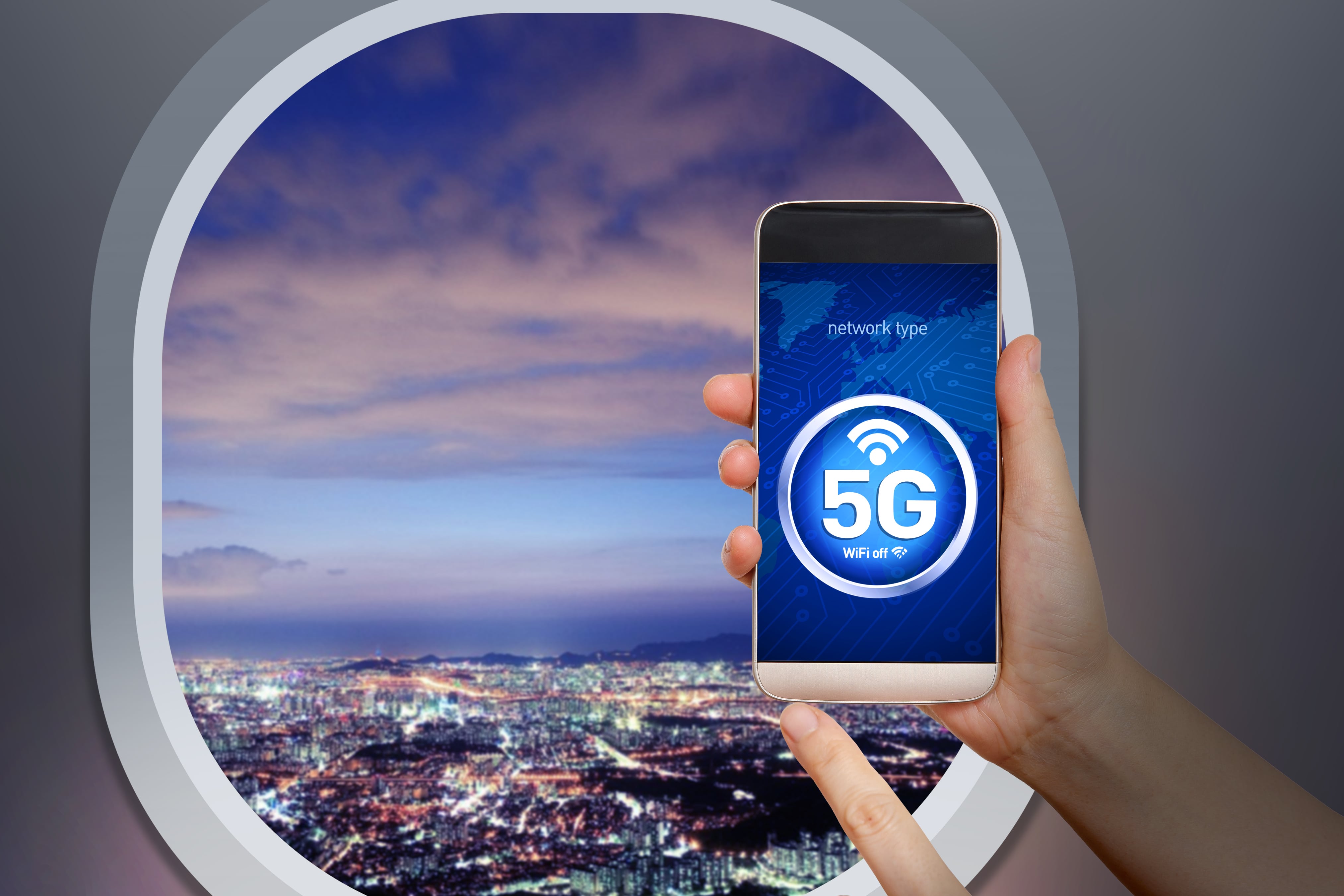5G in Aviation: A New Horizon

From check-in and immigrations to ground control and inflight connectivity, here’s how 5G can transform the aviation industry.
Anyone who’s ever been on an airplane knows how it can quickly change from a pleasant experience to a painful one. The check-in procedure can be arduous, and flights can be delayed. Luggage can be misplaced, and your seatmate’s intruding elbow can be the bane of your existence.
We’ve talked about how 5G can transform industries--from healthcare and manufacturing to retail and financial services. With its fast data speed, low latency, and high bandwidth, 5G promises to enhance existing applications and enable new technologies.
How can 5G streamline operations in airports and flights, making the traveler’s experience more enjoyable and the company’s bottom line bigger? Let’s take a look.
5G in airports
5G can help mitigate pandemic risks while thinning bottlenecks and optimizing ground operations.
Passenger processing
On average, passengers spent about 1.5 hours in travel processes before the COVID-19 pandemic, according to the International Air Transport Association (IATA). The IATA says that processing time has ballooned to three hours during peak time.
And while the travel industry has not yet fully recovered from the impact of COVID-19, streamlining passenger processing while following strict hygiene protocols is crucial to the industry’s survival. Here’s how 5G can make that happen.
- Thermal imaging and automatic fever detection with 4K cameras or AR thermal glasses
- Self-service facial recognition and biometrics for contactless entry and automatic boarding
- AI-assisted computer vision to analyze foot traffic and optimize passenger flows
- Cameras and sensors to ensure social distancing
- Mobile concessions, including in-app ordering and delivery as well as self-service payment kiosks
- Cleaning and maintenance by automatic guided vehicles (AGV) and UV disinfection systems
“Passenger process systems, such as self-service technologies and biometric ID management, connected to 5G and WiFi, will benefit through the faster transmission to data,” says Giles Bloch-Morhange, Vice President of SITA Platform, an IT provider for the air transport industry. “Video feeds underpinning biometric ID management systems will enable face recognition to occur in real-time--5G will allow data to be sent back and forth to the police, border control and airlines instantaneously to give the red or green light.”
Airport operations
Experts claim that the 5G network can support up to one million connected devices per square kilometer, ten times more than 4G. Coupled with faster speeds, low latency, and increased data transfer, 5G can enable improved monitoring and analysis of airport assets.
5G can make airport operations more efficient and cost-effective. Here are a few use cases.
- A connected ground support equipment (GSE) fleet to optimize usage and monitor efficiency, saving on fuel costs and labor
- Data on equipment usage to enable predictive instead of corrective maintenance
- Airport inspections for infrastructure checks using autonomous drones
- Aircraft maintenance using augmented reality (AR)
- IoT sensors provide temperature and weather data to inform maintenance and repair decisions
- Autonomous tugs to make the luggage process faster and more reliable
- Smart cameras to identify and match bags to owners
“The speed and flow of data, and the sheer potential to use historic, predictive and real-time data, offers solutions that seemed light years away, only a few years ago,” says Nina Brooks, director of security, facilitation, and IT at Airport Council International (ACI) World, a non-profit organization that represents the world’s airports.
“These advances will enable much stronger collaboration between airports, airlines, ground handlers, air traffic managers, suppliers, and retailers, and make their interactions seamless and faster,” says Brooks.
5G in airports around the world
From Germany and France to China and Thailand, the airport sector is collaborating with telecom players to make their airports smarter.
5G in airplanes
Vast amounts of data generated by airplanes can be captured and analyzed to enable faster, more informed decisions inflight. It can also optimize operations and make aircraft turnaround more efficient. Inflight connectivity can increase a passenger’s productivity and overall enjoyment during the flight.
Flying data centers
Experts project that the global fleet could generate 98 million terabytes of data by 2026. In one day, new-generation commercial aircraft can produce more than 30GB of data.
Faster data speeds will enable aircraft to capture and share more inflight information with ground teams, air traffic management, and other aircraft. This will improve overall efficiency and provide better insights.
“Real-time information can be used for optimizing aircraft status and maintenance needs, fleet operations and cargo and crew management, as well as the ability to assess things like landing conditions,” says Giles Bloch-Morhange, Vice President of communication and data exchange at SITA.
Here are some benefits of 5G in airplanes:
- Increase flight safety with real-time transmission of cockpit flight data
- Reduce maintenance issues
- Prevent technical delays
- Identify and predict failures using AI
- Increase fuel efficiency
- Minimize flight schedule changes
- Reduce operational costs
Inflight connectivity
How do airplanes flying more than 900 kilometers an hour and tens of thousands of meters up in the air even get connected? There are two ways airplanes get inflight Wi-Fi: ground-based connectivity and satellite connectivity.
One of the many things that the COVID-19 pandemic has shown us is that the Internet is no longer a luxury but a necessity. From school to work to shopping, we now conduct our daily routines online.
In an October 2020 passenger survey, 39% of respondents agreed that onboard Wi-Fi matters more today than ever before. Of those surveyed, 79% said they would feel more confident during the flight if they had destination status alerts and real-time information on their destination. The survey also revealed that 83% want more contactless payments inflight and 43% want real-time luggage tracking.
Fast, reliable inflight connectivity is crucial to those who must do business in the skies. Three companies on three different continents are striving to make that happen: Deutsche Telekom in Germany, Gogo Business Aviation in North America, and ZTE in China.
Deutsche Telekom
“In Germany alone, we’re upgrading or installing up to 2,000 new sites ready for 5G every year. We consider 5G as the natural evolution of LTE or LTE advanced,” says David Fox, Vice President of in-flight and connectivity services for Deutsche Telekom.
While the company’s European Aviation Network (EAN) inflight broadband service is currently based on 4G (LTE) technology, Deutsche Telekom is on track to make the shift to 5G, which will “enhance capacity, performance and the overall user experience for our customers, while also ensuring backwards compatibility for 4G services."
Gogo Business Aviation
In the United States, Gogo will use its existing infrastructure of more than 250 towers to transmit unlicensed spectrum in the 2.4 GHz band using the air-to-ground (ATG) system.
Last June, Gogo conducted a flight test and successfully established a connection between the 5G belly-mounted antennas on the aircraft and the two 5G antennas on a ground tower.
“What we’ve done is validate that our systems can talk to one another,” says Mike Syverson, senior vice president of engineering for Gogo. “The antennas can talk to the cell site, which in turn can talk to the data center. There is a lot of software development to put those pieces together, and it’s all working very well.”
During the testing, Gogo also successfully performed an end-to-end call using a 5G SIM card, from the onboard equipment to the cell site, through the data center to the internet, and back. “What we’ve done is confirm that our systems can talk to one another,” Syverson shares. “The antennas can talk to the cell site, which in turn can talk to the data center. There is a lot of software development to put those pieces together, and it’s all working very well.”
ZTE
China looks set to launch the world’s first in-flight 5G with ZTE, with at least two major domestic airlines close to deployment as of May this year. In an interview with Runway Girl Network, Liu Weiwei, General Manager of ATG Products at ZTE, revealed that two of the top five airlines in China are close to deploying the company’s 5G ATG inflight connectivity solution.
According to Weiwei, China’s airspace could be covered with fewer than 1,000 5G New Radio (NR) base stations, with a “maximum 300km radius for one NR station”.
“Generally speaking, in future all single-aisle planes will be equipped with 5G ATG for domestic passengers, which accounts for a large majority of the total civil aircraft. In the meantime, as the private aircraft market increases, it becomes another source of potential customers for 5G ATG,” Weiwei told The Mobile Network.
Watch this video to know more about ZTE’s 5G ATG inflight connectivity technology.
5G and radar altimeters
While 5G inflight connectivity proposes many benefits for both passengers and airlines, some experts have raised concerns about how it can affect radar-altimeter system operation and flight safety.
A radar altimeter is an airborne electronic device that uses radio waves to measure an aircraft’s distance from the ground. Operating in the 4.2–4.4 GHz band, it is vital to safety and navigation functions such as Terrain Awareness Warning Systems (TAWS), Traffic Alert and Collision Avoidance Systems (TCAS), Airborne Collision Avoidance Systems, and autoland systems.
Last December, the U.S. Federal Communications Commission (FCC) announced plans to reallocate a portion of the 3.7 to 3.98 GHz frequency range for 5G telecommunications systems. In response, the Radio Technical Commission for Aeronautics (RTCA), which develops technical standards for aviation, published a white paper evaluating how radar altimeter performance could be affected by radio frequency interference from 5G systems.
The report reveals there is a “major risk” that 5G systems in the 3.7 to 3.98 GHz frequency range will cause “harmful interference to radar altimeters on all types of civil aircraft.” The RTCA pointed out the possibility of “catastrophic failures leading to multiple fatalities, in the absence of appropriate mitigations.”
Many aviation advocates have also spoken out against the FCC’s decision. Air travel regulators around the world, including the French Civil Aviation Authority and the UAE’s General Civil Aviation Authority (GCAA), have issued safety notices.
Every new technology comes with a unique set of opportunities and challenges. 5G networks in our airports and the skies could mean better productivity, efficiency, and overall performance for passengers and airport stakeholders. After more than a year of gray skies, the aviation industry needs a brighter horizon for recovery. We must navigate new regulations and complexities surrounding safety and security before these technologies should take flight.
As one of the Top 21 EMS companies in the world, IMI has over 40 years of experience in providing electronics manufacturing and technology solutions.
We are ready to support your business on a global scale.
Our proven technical expertise, worldwide reach, and vast experience in high-growth and emerging markets make us the ideal global manufacturing solutions partner.
Let's work together to build our future today.



